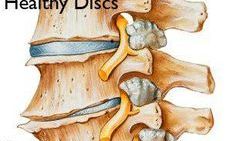What is Degenerative Disc Disease (DDD)?
Degenerative Disc Disease is the narrowing of the space between the vertebrae of the spine. It sounds nasty, but is very common as we age and most people can be diagnosed with having this condition but don’t have some of the symptoms that come along with it. The disc’s in our spine provide multiple functions in our torso, like, twisting, bending, and shock absorption. As we get older these disc will naturally compress which narrows the space between the vertebrae and this begins to affect mobility and in some case encourage compression of the nerves leaving the spine. Even though it is more common in older populations, people with disc injuries or genetic predispositions for the condition can develop degenerative disc disease at an earlier age.
Can you prevent Degenerative Disc Disease?
Prevention is not an option as this is a natural process as we age. The good news is, many people already have the condition but experience very few symptoms that can be related to this condition. There are some things you can do to reduce symptoms related to degenerative disc disease:
- Stop smoking – Smoking is not a main cause to degenerative disc disease, but contributes to a lot of conditions that are related to DDD, such as, hypertension, obesity, cardiovascular issues.
- Proper nutrition – Eating a healthy balanced diet helps maintain proper weight and decreases risk of cardiovascular problems, which significantly contribute to DDD.
- Exercise – Exercise helps keep the back strong and provides extra support for the spine decreasing the risk of injury
- Stretch – Proper flexibility and mobility in the spine decreases the risk of injury and can decrease symptoms related to DDD.
When should I seek medical attention?
Living with degenerative disc disease doesn’t mean you have to live in pain. There are many treatment options that can help address pain related to DDD and improve overall quality of life. Physical therapy and chiropractic care can help by breaking the cycle of pain. Some people call these “Flair-ups”. Often people may experience a minor back injury and the result guarding (tightening) of the muscles around the spine activating the symptoms related to DDD. While this is the way the body protects the injured area it is actually counterproductive to the healing process. Effective treatment can include, spinal decompression, massage, stretching and strengthening. Find a medical provider that specializes in this treatment in order to get the best results.
